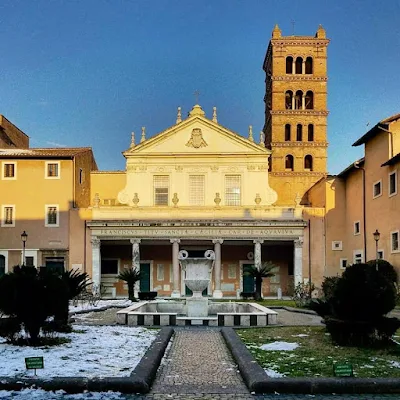Since we have two Roman pilgrims following the Lenten Stations this year, we have twice as many photos, so I have been been posting only four churches at a time, to keep the posts to a manageable length. Even so, it’s been difficult at times to choose among so many beautiful images; our thanks once again to Fr Alek Shrenck of the diocese of Pittsburgh, and Roman native Agnese Bazzucchi, for sharing them with us.
Tuesday of the Second Week - Santa Balbina
From Fr Alek: some of the art works of the church, which contains a fair amount of medieval fresco work, not in the best condition.
The church was historically a dependent of St Peter’s, and contains some interesting artifacts from the ancient basilica, such as this Crucifixion by Mino da Fiesole (1429-84.) The inscription at the bottom says “This most holy image, formerly in the Vatican on the altar of Peter Cardinal Balbo (later Pope Paul II, 1464-71), was taken thence from the crypt and brought here in the Jubilee year 1650.”
The stem of the chapter of St Peter’s
The cosmatesque tomb of Cardinal Stefano de Surdis, who died in 1303
Wednesday of the Second Week - Santa Cecilia in Trastevere
Going into the church morning station Mass celebated by the North American College (Fr Alek.)
Before the evening Mass organized by the Vicariate of Rome (Agnese.)
The procession through the courtyard in front of the church, which may very likely not be done over snow and slush for another decade or two.
Relics on the high altar.
From Fr Alek: part of the fresco in the ceiling of the nave, by Sebastiano Conca, Christ crowning St Cecilia in heaven.
A particularly good shot of the crypt.
Thursday of the Second Week - Santa Maria in Trastevere
Before the morning Mass (Fr Alek.)
The church underwent a complete top-to-bottom restoration in the reign of Blessed Pius IX, including the late 16th century coffered ceiling. Only one other Pope after Peter, St John Paul II, could ever write in an inscription like the one we see here that he did something “in the 26th year of his Pontificate.”
This inscription, also from the ceiling, reads “In this first church of the Mother of God, formerly a taberna meritoria, a fount of oil bursting out of the ground foretold the birth of Christ.” In ancient Roman times, a taberna meritoria was a tavern for retired soldiers. A tradition recorded by both Eusebius of Caesarea and St Jerome says that a fountain of oil sprung up out of the ground on the night of Christ’s birth, a sign to the Jews of Rome, who mostly lived in Trastevere, the foreigners’ quarter in antiquity. (It is certain that there was a church on the site of Santa Maria in Trastevere in very ancient times, but there is no evidence that it was dedicated to Mary, and Santa Maria Maggiore remains the oldest church in the world which was certainly dedicated to Her from its foundation.)
The evening procession with the relics of the Saints (from Agnese.)
Friday of the Second Week - San Vitale “in Fovea”
San Vitale was first dedicated in the year 416; modern constructions around it, including the street on which it sits, the via Nazionale, are on a much higher level, and one must now descend a rather large staircase to reach the church. Agnese took this photograph from the top of the stairs!
From Fr Alek























